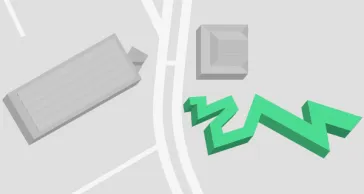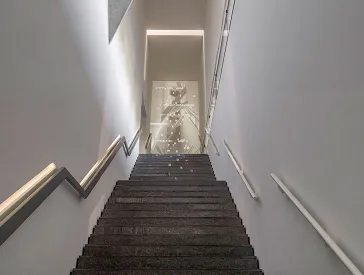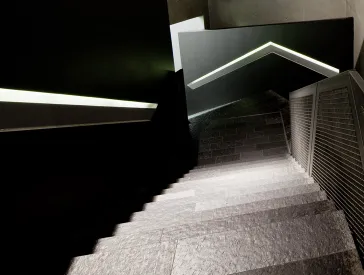Im Augenblick
Fotografien von Fred Stein
Diese Retrospektive präsentierte Fred Steins vielschichtiges und umfangreiches Werk erstmals in Deutschland und zeigte über 130 Schwarz-Weiß-Fotografien mit Straßenansichten aus Paris und New York, aber auch zahlreiche Porträts.
Zur Veranschaulichung von Biografie und Arbeitsweise des Fotografen wurden zudem private Dokumente, Original- und Kontaktabzüge ausgestellt.
Ausstellung bereits beendet

Wo
Libeskind-Bau EG, Eric F. Ross Galerie
Lindenstraße 9–14, 10969 Berlin
Fred Stein
Ein Augenblick kann entscheidend sein – im Leben wie in der Fotografie. Für den Fotografen Fred Stein waren es diese kurzen Momente, die sein Leben bestimmten, persönlich wie beruflich.
Die Kuratorinnen Theresia Ziehe und Jihan Radjai geben eine kurze Einführung in die Ausstellung; Jüdisches Museum Berlin
Als Sohn eines Rabbiners 1909 in Dresden geboren, wurde der überzeugte Sozialist Fred Stein nach der Machtübernahme der Nationalsozialist*innen gezwungen, seine Position als Jurist aufzugeben und Deutschland zu verlassen. 1933 konnte er unter dem Vorwand einer Hochzeitsreise mit seiner Frau Lilo nach Paris fliehen.
Dort stand er vor der Herausforderung, aus dem Nichts eine neue Existenz aufbauen zu müssen. Eine Kleinbildkamera der Marke Leica, die sich Fred und Lilo Stein gemeinsam zur Hochzeit schenkten, gab den entscheidenden Impuls: Die Fotografie wurde seine neue Profession.
Fred Stein, fotografiert von Lilo Stein (1910-1997), Paris 1937; Estate of Fred Stein CC BY-SA 3.0 via Wikimedia Commons
Fred Stein
In Paris konnte Fred Stein nach kurzer Zeit ein eigenes Fotostudio einrichten. Bereits ab 1935 beteiligte er sich an mehreren Ausstellungen, zusammen mit namhaften Fotografen wie Ilse Bing, Brassaï, Man Ray, Dora Maar und André Kertész.
Nach Ausbruch des Krieges mussten die Steins mit ihrer 1938 geborenen Tochter erneut fliehen.
1941 erreichte Familie Stein mit einem der letzten Schiffe New York. Dort nahm Fred Stein die Fotografie wieder auf und nutzte, neben der Leica, eine Mittelformatkamera der Marke Rolleiflex. Die einfache Handhabung dieser Kameras ermöglichte es ihm, durch die Straßen zu flanieren und die Stadt und ihre Menschen in kurzen, aber entscheidenden Augenblicken festzuhalten. Zeit seines Lebens konzentrierte Fred Stein sich auf Straßenansichten und Porträts.
Fred Steins Biografie (Überblick)
|
1909 |
Alfred (Fred) Stein wird am 3. Juli als Kind der Religionslehrerin Eva Stein (geb. Wollheim) und des Rabbiners Leopold Stein in Dresden geboren |
|---|---|
|
1919–1927 |
Besuch des König-Georg-Gymnasiums in Dresden |
|
1927–1932 |
Studium der Rechtswissenschaften in Heidelberg, Berlin und Leipzig, anschließend Referendariat in Dresden und Bautzen |
|
1933 |
Entlassung als Rechtsreferendar und Ablehnung der Doktorarbeit aufgrund des Berufsverbots |
|
ab 1934 |
Aufenthalt in Paris |
|
1935 |
Erste Ausstellung gemeinsam mit namhaften Fotografen wie Ilse Bing, Brassaï, Man Ray, Dora Maar und André Kertész |
|
1938 |
Geburt der Tochter Marion |
|
1939–1941 |
Deportation und Internierung in verschiedenen Lagern für feindliche Ausländer |
|
1941 |
im Mai: Ausreise von Marseille in die USA auf der SS Winnipeg mit Hilfe von Varian Fry und dem Emergency Rescue Committee – im Gepäck seine Negative und einige ausgewählte Abzüge |
|
1943 |
Geburt des Sohnes Peter |
|
1950 |
Fred Stein muss wegen eines schweren Hüftleidens die Straßenfotografie aufgeben |
|
1952 |
Einbürgerung in die USA |
|
1958 |
Erste Deutschlandreise nach der Flucht vor 25 Jahren |
|
1967 |
Fred Stein stirbt am 27. September im Alter von 58 Jahren in New York |
Soziologie der Straße
In den Städten seiner Emigration – in den 1930er-Jahren in Paris und ab den 1940er-Jahren in New York – fotografierte Fred Stein unzählige Straßenansichten, darunter auch Aufnahmen aus den jüdischen Vierteln.
Fred Stein
Neben klassischen Motiven der beiden Metropolen entstanden zahlreiche Milieustudien und Charakterbilder. Sie stehen in einem soziologischen Kontext von Armut und einfachem Leben in der Stadt und zeigen Straßenarbeiter*innen, Verkäufer*innen, Obdachlose und Familienszenen.
Fred Steins Blick verbindet das Alltägliche mit einem Sinn für den außergewöhnlichen Moment. Ebenso fällt sein Humor ins Auge, der in vielen seiner Bilder aufblitzt.
Psychologie des Porträts
Fred Stein bemühte sich, die Personen, die er porträtierte, vor der Aufnahme kennenzulernen. Er setzte sich mit deren Werk und Denken auseinander. Nicht selten trat das Foto zugunsten hitziger Diskussionen in den Hintergrund. Oft wurde erst am Ende eines Treffens das Negativ belichtet. Viele Porträts enthalten so noch Spuren der Gespräche.
Fred Stein
Über 1200 Porträts entstanden auf diese Weise. Sie lesen sich heute wie ein Who's who prominenter Persönlichkeiten des 20. Jahrhunderts. Fred Stein verzichtete auf dramatische Lichteffekte oder nachträgliche Retuschen. Der Sinn der Porträtfotografie bestand für ihn darin, „einen Ersatz (im Wege der Fotografie) für den lebenden Menschen zu schaffen, ein Bild, das über den äußeren und inneren Menschen aussagt“
, wie er in einem Brief darlegte.
Porträtaufnahmen von Fred Stein
Eine Ausstellung des Jüdischen Museums Berlin, kuratiert von Theresia Ziehe und Jihan Radjai.
Mitschnitt der Ausstellungseröffnung am 21. November 2013 mit den Redebeiträgen der Kuratorinnen Theresia Ziehe und Jihan Radjai; Jüdisches Museum Berlin
Informationen zur Ausstellung im Überblick
- Wann 22. Nov 2013 bis 4. Mai 2014
- Wo Libeskind-Bau EG, Eric F. Ross Galerie
Lindenstraße 9-14, 10969 Berlin
Zum Lageplan
Fred Steins Sohn Peter spricht bei der Ausstellungseröffnung am 21. November 2013 (auf Englisch); Jüdisches Museum Berlin
Weitere Stationen der Ausstellung
|
Düsseldorf |
Fred Stein: Auf dem Weg. Dresden – Paris – New York |
|---|---|
|
Dresden |
Fred Stein. Dresden – Paris – New York |
Unterstützer
Für die freundliche Unterstützung danken wir Peter Stein und Dawn Freer und der US-Botschaft.

Medienpartner





